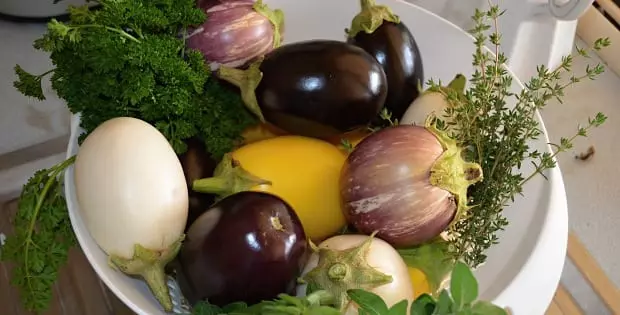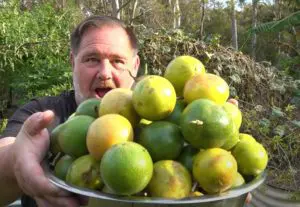How to grow eggplant (or often called aubergine by the British) is exactly what this article is about and whilst you can read the instructions from a packet of seeds or the glossed over generic points in a gardening mag or book nothing beats a raving online post like this from someone like me who’s mad about this amazing vegetable.
I don’t know… As a kid I was never fond of eggplant in any form but these days I really appreciate how good eggplants are to grow, cook, and of course eat.

An assortment of home grown eggplants straight from the garden (image above)
I guess my early memories of eggplant were not flattering and when I think back to my early experiences of thickly sliced baked eggplant discs with the skin still on served unlovingly and unseasoned next to a nice piece of protein it’s no wonder I left it on the plate.
And it wasn’t just the look of unloved eggplant discs on a plate that turned me off, it was also the bitter taste and fury feeling on the palate that made me obverse to anything eggplant for many years.
However, as we all do, my experience with food developed over the years and I found out eggplant not only does taste good when prepared with even the slightest bit of love but it’s diverse, interesting, and a top performer in the home vegetable garden.
Growing
Eggplants are related to the tomato and also part of the tobacco family, in fact, eggplants and tomato plants can be grafted together to make one plant, so can potatoes to create a plant which grows fruit above ground and tubers below – how about that?

Image above shows a Thumbs-up variety of eggplant 🙂
Eggplants are best grown in the height of summer as they thrive off high temperatures and love heavy rainfall. They grow well in pots as long as they are given adequate water and not left to dry out; however, I have found growing eggplants in a raised vegetable garden bed the best way.
Prepare the bed with well-rotted manure and a sprinkle of blood & bone, Dynamic lifter, or chicken manure pellets. Throw a little garden lime around and water that in before planting the seedlings out at about half a metre apart.
Keep well watered until the seedlings take and start growing nicely then continue to water regularly (depending on how heavy the soil is you may water less but the trick is to not let eggplant get too thirsty).
If growing eggplant from seed in a cool climate, it’s probably best to sow in seed trays and start those in a warm spot at least over 18 °C (64 °F) but in warm climates the seeds will easily develop in location.
Having said that, I wouldn’t say eggplant seeds are as easy as tomatoes to germinate but they are still pretty easy just the same. I’ve often had eggplant seedlings pop up in the garden from old fruit and sometimes I even grow new plants from the seed of current plants in the one season still with plenty of time for the successive sowings to fruit (I do live in the subtropics).

Standard eggplants grow to about 1/2 metre high (image above)
To make a bushier plant some people recommend pinching out the tip of the plant when the seedling gets to about 20 – 25 centimetres high and later pinching out some branches: I don’t do this personally and I don’t think it’s required but I guess it’s something to keep in mind if your plant is looking a little leggy.
Thinning out the fruit to one per stem will usually result in larger fruits; again, this is something I don’t do and I have had great results with good sized fruit and large crops off the one plant by simply ensuring the eggplant has adequate food and water (and support).
There’s nothing wrong with smaller sized eggplant fruit anyway and the ones picked a little smaller, even from a larger growing variety, taste better in my opinion.
Most eggplants do require some sort of support like a stake or frame otherwise the weight of the fruit will pull the plant over. However, I have grown several medium and smaller varieties which didn’t require any support at all but still produce lots of fruit – some plants are stronger than others too.
Not mandatory, but it doesn’t hurt to give the plants another feed of fertiliser around mid-season to help maintain strong growth and more fruit. It’s possible to grow eggplants as a perennials, particularly in warmer climates, although I wouldn’t bother because they grow fast enough anyway and second season eggplants won’t produce the quantity or quality of fruit compared to a new plant. 
Fruit is produced after white or purple flowers and once the fruit sets it grows rapidly! Most fruit will have a few spikes at the base so keep that in mind when picking. The easiest way to harvest the fruit is by cutting it from the plant rather than pulling or twisting.
Try not to let the fruit hang on the plant for too long otherwise eating quality diminishes and it’s better to harvest immature fruit than fruit that is too old.
The varieties of eggplants are so vast it’s not really worth listing them because it’s best to go out and select your own from whatever is on offer locally or online and have fun experimenting. They come in all shapes, sizes, and colours, and look very pretty in the garden from the deep purple (almost black) to the shiny white or even striped ones.
Pests & diseases
Although eggplants are easy to grow and thrive in the right conditions, they still are susceptible to pests and disease and the biggest threat is the latter. Pests can be annoying at times but disease can quickly destroy a perfectly healthy eggplant (or crop) and there isn’t much we can do about it once it happens. Not all diseases devastate (some are rather mild and the worst they do is some leaf and fruit damage); however, if the signs of fatal disease can be found early there's a chance some healthy plants can be saved.
Through my own experience, the biggest threat to eggplants is Verticillium Wilt caused by a particular type of fungi in the soil and once the plant gets infected there’s no cure. The signs and symptoms of Verticillium Wilt are a sudden wilting of some limbs and leaves with dieback soon after. The disease slowly spreads until the whole plant eventually dies.
There are other similar diseases and unless you’re a specialist they are difficult to diagnose, but the bottom line is if your eggplants are showing signs of wilting disease then rip them out and destroy them. Then, quarantine that section of your garden and grow other things not related to the Solanaceae family (tomatoes, potatoes, capsicum, eggplant, etc). 
I recently had a bad start to my eggplant season losing several plants to wilt but I persisted with replacing the eggplants with others planted in different areas and ended the season with bumper crops.
Just to complicate things, eggplants will also wilt if affected by nematodes which are a microscopic worm (pest) that gets into the plants roots and causes deformities looking like knotted string (root-knot nematodes).
Even though there are chemical solutions to combat nematodes try to resist the temptation and solve this problem in the same way as mentioned for Verticillium Wilt. Also, incorporate more organic material into the soil (like manure) and perhaps grow some nematode repellent plants such as marigolds.
Apart from that, eggplants can fall victim to: tomato caterpillar, mites, whitefly, 28 spotted ladybird (the only bad ladybird), and a range of other common pests but the best way to protect the plants is to ensure they are well fed and watered. If you do this, attack from pests will be minimal and any damage done will be overcome by the healthy plant on its own. It goes without saying if you find a pest like a caterpillar simply pick it off by hand instead of spraying.
Eating and cooking
One of the most famous ways to eat eggplant is when it's made into an antipasto (which is usually a selection of cured meats and preserved vegetables served as an appetiser before the main meal).
If you are making an antipasto eggplant then younger smaller fruits are better than older or large varieties because they grill better and hold together whereas the larger and older fruit tend to be grainer and softer when cooked.
Essentially, preserved eggplant is simply grilled eggplant preserved in oil which had been infused with garlic and seasoned with salt and pepper. The salt is used at the beginning sprinkled over the sliced eggplant to draw out extra moisture (and some say bitterness too) before it’s grilled. See my recipe on our forum here.
Naturally, eating eggplant as a cooked vegetable side to a main is still popular but as per my intro I think this is the worst way to present eggplant on the plate! A better way is to roast the eggplant stuffed or in halves and filled with herbs, spices, and other tasty ingredients.
Salting eggplant prior to cooking (other than to remove moisture) is a waste of time and I question the notion salting helps to reduce the bitterness of the fruit. If quality produce is used and if the eggplant is cooked with love it will not taste bitter – trust me.
Another good way to use eggplant is as a substitute for pasta sheets in a lasagna by slicing the eggplants thin and using them the same way as pasta to layer the dish.
Don’t forget dips and who doesn’t like a homemade roasted eggplant dip with a few crackers for a clever way to keep the guests snacking and off your back until the mains are done.
That’s just a few ideas on some good uses of eggplant – there are thousands more, just search the net and you’ll see what I mean. Here’s a recipe video I made:
Conclusion
If you are stuck in the eggplant wilderness due to past bad experiences with eggplant like I once was, I encourage you to revisit eggplant and include it in your diet again. This time, grow it and cook it yourself but with a bit of love and you’ll become an eggplant convert in no time at all.
Eggplants are terrific producers and for the home garden are great value for money food plants. They can be made into heaps of different dishes and are seriously healthy to eat… they taste awesome!
If you liked this article share it around hey… Also, I’d love it if you joined our forum and participated in some of our online discussions. Feel free to make a comment below as well because your comment shows search engines you were engaged in the post and this encourages more people to visit our site.
Mark Valencia – Editor SSM
Look, and see the Earth through her eyes…












